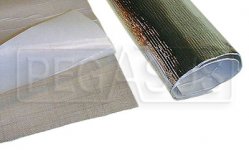bob hughes
Luke Skywalker
Offline
Well it is the beginning if spring here and another mad dash in the ongoing saga of the rolling restoration. This time I am replacing the left had floor and sills ( rockers - why are they called that?)
The old girl is a couple of feet off the ground and I have just stripped out the exhaust and what was left of the insulation to the footwell in readiness for some major cutting.
Looking foward, is there any thing I can do to improve the insulation on this side of the car. There appeared to be an air gap between the insulation and the foot well, created by little square packers, I guess that is the norm, but hot air can circulate into this space and heat up the metal?
The was no insulation above the silencer (muffler), I think that I have bought that in the package form AH is there a gap behind that as well?
Any assistance / tweaks to improve the insulation around this area would be appreciated.

Bob
The old girl is a couple of feet off the ground and I have just stripped out the exhaust and what was left of the insulation to the footwell in readiness for some major cutting.
Looking foward, is there any thing I can do to improve the insulation on this side of the car. There appeared to be an air gap between the insulation and the foot well, created by little square packers, I guess that is the norm, but hot air can circulate into this space and heat up the metal?
The was no insulation above the silencer (muffler), I think that I have bought that in the package form AH is there a gap behind that as well?
Any assistance / tweaks to improve the insulation around this area would be appreciated.

Bob

 Hey there Guest!
Hey there Guest!
 smilie in place of the real @
smilie in place of the real @
 Pretty Please - add it to our Events forum(s) and add to the calendar! >>
Pretty Please - add it to our Events forum(s) and add to the calendar! >> 

 A friendly reminder - be careful what links you click on here. If a link is posted by someone you don't know, or the URL looks fishy, DON'T CLICK. Spammers sometimes post links that lead to sites that can infect your computer, so be mindful what you click.
A friendly reminder - be careful what links you click on here. If a link is posted by someone you don't know, or the URL looks fishy, DON'T CLICK. Spammers sometimes post links that lead to sites that can infect your computer, so be mindful what you click.